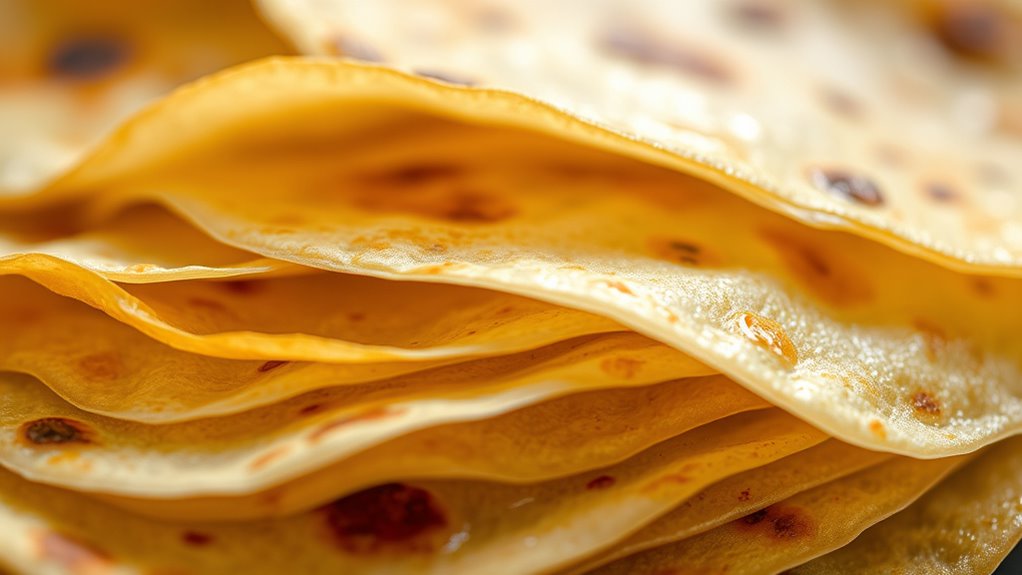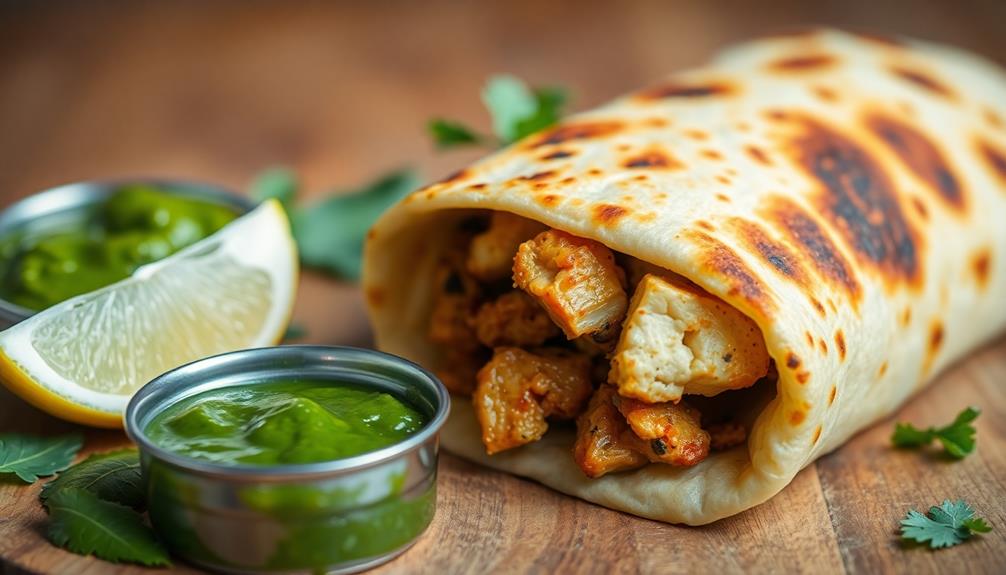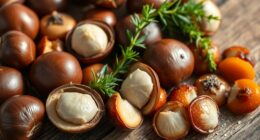The flaky layers in your paratha come from the way dough’s elasticity, gluten development, and fat work together. As you knead the dough, gluten forms a strong network that stretches without tearing, helping layers stay intact. When you add and evenly distribute fat, it creates tiny barriers between these gluten layers, making them separate easily. During cooking, steam pushes these layers apart, creating the light, flaky texture. If you keep exploring, you’ll uncover more about this fascinating process.
Key Takeaways
- Proper gluten development provides elasticity, allowing dough to stretch and form thin, layered structures.
- Even fat distribution creates barriers between gluten layers, aiding in separation and flakiness.
- Folding and rolling increase layer count, with fat trapped between layers to enhance crispness.
- Heat during cooking causes steam expansion, pushing apart gluten layers to produce flaky layers.
- Controlled dough elasticity and temperature ensure the layers separate properly for a light, airy texture.

The flaky layers of a paratha result from a fascinating interplay of physics principles during its preparation. When you roll out the dough, its elasticity plays a pivotal role in creating those thin, even layers. Dough elasticity refers to its ability to stretch and return to its original shape without tearing. By kneading the dough properly, you develop gluten strands that give it this elastic quality. As you flatten and stretch the dough, these gluten networks allow it to expand without breaking, making it easier to layer and fold.
Dough elasticity, developed through proper kneading, enables stretching and layering without tearing for perfect parathas.
Fat distribution is equally essential. When you incorporate fat—traditionally ghee or oil—into the dough, you’re doing more than just adding flavor. The fat gets evenly distributed throughout the dough, creating tiny layers of fat that are trapped between the gluten strands. This distribution is key to achieving those delicate, flaky layers. When you roll out or fold the dough, the fat acts as a barrier that separates the gluten layers, preventing them from bonding tightly. This separation is what leads to the characteristic flakiness once cooked.
As you fold and roll the dough multiple times, you’re fundamentally creating a stack of thin layers separated by pockets of fat. During cooking, the heat causes the water in the dough and fat to turn into steam. This steam expands and pushes against the gluten layers, causing them to lift apart and form flaky, airy layers. The more evenly the fat is spread and the better the dough’s elasticity, the more distinct and crisp these layers become. Understanding gluten development helps you fine-tune the dough’s elasticity and achieve optimal layers. Additionally, controlling the temperature of the dough during handling can influence the final flakiness.
In reality, your careful handling of the dough—ensuring it’s elastic enough to stretch without tearing and that the fat is well-distributed—directly influences the final texture of your paratha. If the dough is too tough or not elastic enough, it won’t stretch smoothly, leading to fewer layers. Conversely, if the fat isn’t evenly mixed, the layers won’t separate properly, resulting in a denser and less flaky paratha. Understanding these physics principles helps you control the process, so each bite delivers that perfect, layered crunch that makes a paratha so irresistible.
Frequently Asked Questions
How Does Temperature Affect the Flakiness of Paratha Layers?
When you cook a paratha, temperature plays a vital role in its flakiness. As heat transfer occurs during cooking, the dough heats unevenly, causing thermal expansion in the layers. This expansion helps separate the layers, making the paratha flaky. If you cook at the right temperature, the heat transfer is controlled, ensuring maximum expansion and crispiness. Too high or too low, and the layers won’t expand properly, affecting flakiness.
What Role Does Dough Elasticity Play in Layering?
Dough elasticity is essential for layering because it influences gluten development, which makes the dough stretchable and resilient. When you knead the dough properly, it develops strong gluten strands that allow you to stretch it without tearing. This elasticity helps you create thin, even layers, trapping air and fat between them. As a result, the dough can be layered effectively, producing those flaky, crispy layers characteristic of a well-made paratha.
Can Humidity Influence the Layer Formation Process?
It’s interesting how humidity effects can unexpectedly influence your paratha layers. When you work in a humid environment, moisture absorption into the dough can make it softer and more pliable, which might hinder the crisp, flaky layers you aim for. Conversely, low humidity helps preserve the dough’s elasticity, allowing the layers to puff and separate easily. So, controlling humidity levels guarantees consistent, perfectly flaky parathas every time.
How Does Fat Distribution Impact the Flaky Texture?
You should consider how fat distribution influences the flaky texture by affecting fat layering and dough lamination. Evenly distributed fat creates thin, separate layers during rolling and folding, leading to a crisp, flaky paratha. If fat is unevenly spread, layers stick together or break, reducing flakiness. Proper fat layering guarantees the dough lamination process produces those desirable, tender, and flaky layers you enjoy.
Are Certain Flours Better Suited for Flaky Paratha Layers?
You might find it surprising, but certain flours naturally lend themselves better to flaky paratha layers. High-protein flours with strong gluten development create a resilient dough, making it easier to fold and layer. Look for flours with higher gluten content, like bread flour, to achieve those crisp, flaky textures. The key is choosing a flour with the right protein level, which influences gluten strength and ultimately, the flakiness of your paratha.
Conclusion
So, next time you tear into a flaky paratha, remember you’re not just enjoying delicious layers—you’re witnessing physics in action. The delicate dance of gluten, fat, and temperature creates those irresistible layers, turning simple ingredients into a masterpiece. Think of it as a culinary symphony, where each element plays its part perfectly. Truly, understanding the science behind your favorite snack makes every bite even more satisfying—proof that physics isn’t just in textbooks, but in your kitchen too.









